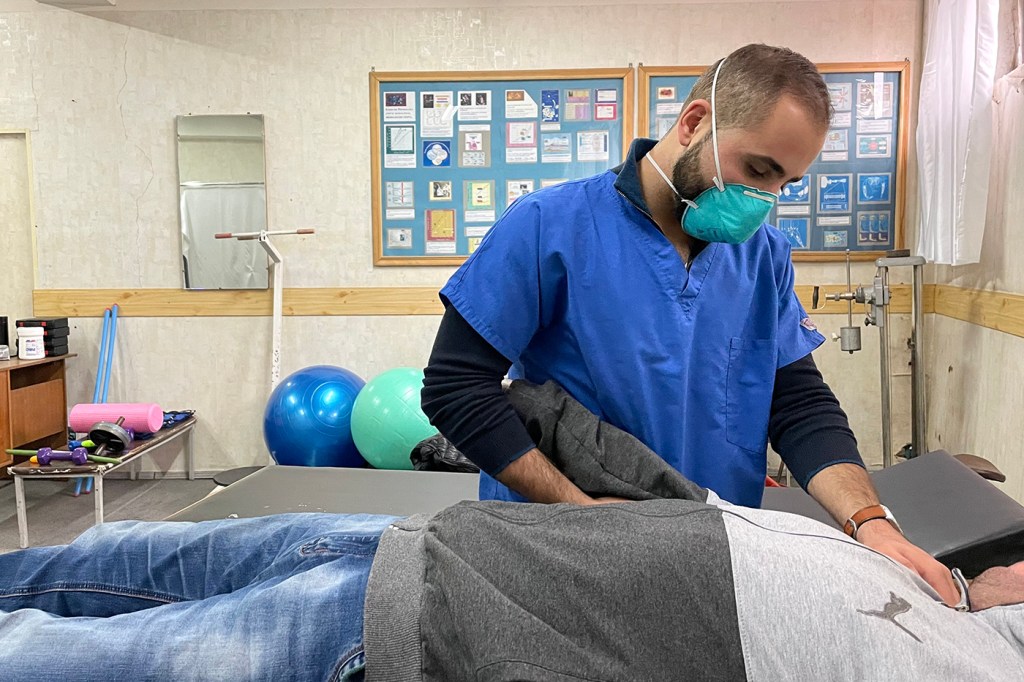This Bouvé graduate is helping his war-ravaged country of Armenia heal with physical therapy

In late November, while most Americans were busy planning their holiday get-togethers, Haig Haroutunian was dealing with more pressing matters.
After seeing news footage of the war-ravaged bodies of young Armenian soldiers, the licensed physical therapist and Bouvé College of Health Sciences graduate immediately set off from Boston to stay with relatives in his native country to help heal his compatriots’ emotional and physical scars.
“I wanted to do something to help,” he says.
Armenia is about the size of Maryland and has produced notables such as reality TV star Kim Kardashian and tennis champion Andre Agassi. It is the smallest of the former Soviet republics, surrounded by Georgia to the north, Azerbaijan on the east, Turkey on the west, and Iran to the south.
Armenia has been clashing with Azerbaijan for decades over ownership of Nagorno-Karabakh, a mountainous region controlled by ethnic Armenian factions but inside the internationally recognized borders of Azerbaijan. Several cease-fire attempts have come and gone over the years.
“Today Nagorno-Karabakh is a reminder of the importance of autonomy, sovereignty, and statehood,” explains Julie Garey, assistant teaching professor of political science who specializes in international relations, U.S. foreign policy, and national security.
“The region was declared autonomous after World War I, but being an autonomous region does not carry the same weight as being a state.”
Thousands of lives have been lost in the territorial dispute, and many thousands more forever altered by devastating injuries. Shortly after touching down in the Armenian capital of Yerevan in late November, Haroutunian began the wrenching process of picking up where surgeons leave off after mending soldiers’ broken bodies. What he saw were no ordinary injuries.
“There were tiny shrapnel wounds caused by explosives dropped from drones,” Haroutunian says.
Trauma from small, metal fragments is often worse than a bullet because once the projectile enters the body it either exits or becomes dislodged, and can generally be removed, he explains.
“But if we’re talking about pieces of shrapnel that could be half a centimeter in size and lodged in obscure places, a lot of times they can’t be removed, and they stay in the body, threatening surrounding organs.”
Azerbaijan’s increasing use of armed drones provides air power at a fraction of the cost of a traditional air force, according to news reports. The situation in Nagorno-Karabakh also underscored how drones can suddenly shift a long-standing conflict and leave ground forces highly exposed.
“Soldiers were being picked off by drones,” Haroutunian says.
Shrapnel injuries to nerves cause significant pain or numbness, affecting the limb’s function.
“A lot of people were walking around with what’s called ‘drop foot’,” Haroutunian explains. “If shrapnel hits a nerve in the leg, then some of the muscles that help with walking just stop working, and people walk around either with a limp, or require crutches or a wheelchair.”
Haroutunian was never in harm’s way, working mostly at a distance from the fighting in an old Soviet rehabilitation center. “It’s not a pleasant place to be by any means,” he says.
The 160-bed, government-run facility was put out of commission years ago but is now up and running again due to an overwhelming volume of patients. The pandemic has further strained Armenia’s health-care system, adding to the crisis.
Not only did he help the wounded recover from bone fractures, nerve damage, lacerated tissue, and amputated limbs, but Haroutunian also helped mend deep, third-degree burns caused by white phosphorus. The chemical is held by militaries around the world and is used legally in combat as a smokescreen in daytime and as an incendiary to light up an area at night. It is illegal to use against civilians.
The 2018 Bouvé graduate provided hands-on therapy, educating patients about their injuries, the importance of home exercise programs, and the dangers of being sedentary. But he was also there to provide compassion and empathy, the soft skills that often determine a patient’s chances of rebounding from war wounds.
“The soldiers truly appreciated seeing somebody from the [United] States take time off from their own work and come for several weeks to help them out,” he says. “That was big for a lot of them.”
Patient trust is integral to a successful patient-therapist relationship, explains Eric Folmar, associate department chair and associate clinical professor in Northeastern’s Department of Physical Therapy. Empathy and compassion are at the core of the trust-building process.
Physical therapists by their nature are drawn to helping others, Haroutunian says, with sympathy and tenderness innate characteristics. It’s a distinctive component of Bouvé’s service-learning program, which encourages engagement with the community.
“Students have numerous opportunities to work with patients in a variety of settings throughout the curriculum,” says Folmar. “They are also encouraged to embrace the many facets of physical therapy to allow them to find the specialty practice that they are truly passionate about.”
Haroutunian, who was born in Cambridge, Massachusetts, spent a semester volunteering at the Madison Park Village apartment complex near the Boston campus, assisting the elderly with therapeutic exercises.
He’s been back in Boston since late December. After three weeks abroad he was glad to return to his full-time job as a home care physical therapist, working with patients in the area. “But I will never, ever forget those soldiers back home,” he says.
For media inquiries, please contact media@northeastern.edu.





